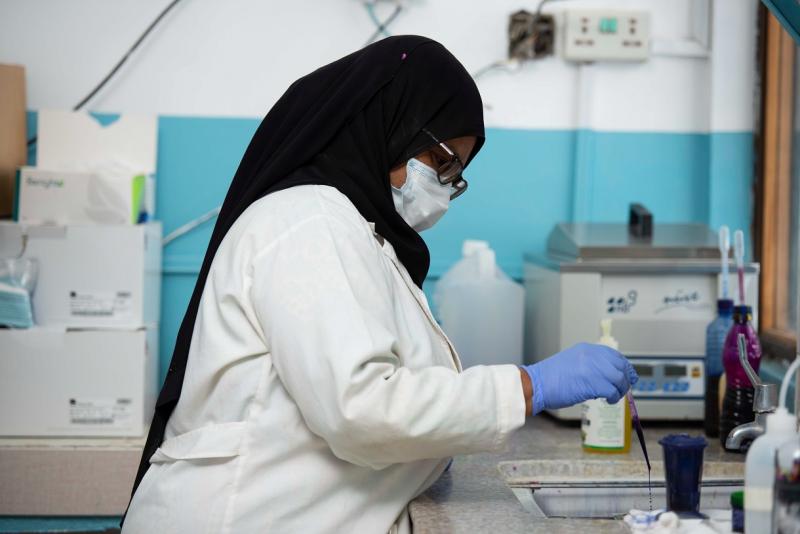Where We Work
See our interactive map



Rukia Ahmed, lab technologist at Tudor Subcounty Hospital in Mombasa County, Kenya, tests patient samples. Photo by Edwin Joe for IntraHealth International.
The Biden-Harris Administration’s Global Health Workforce Initiative is a golden opportunity.
Last week, I joined CEOs and senior officials at 25 other organizations in urging USAID Administrator Samantha Power to include $200 million in her fiscal 2024 budget request to strengthen the Global Health Worker Initiative. This Biden-Harris initiative is a golden opportunity for the US to partner and collaborate with global and regional initiatives—such as the African Union—in a way we never have before.
I signed this letter because we need to support health workers now. Not after the next pandemic is already spreading. Not after our changing climate has intensified our global health challenges and added new ones. But right now. Our future depends on it.
The Biden-Harris Global Health Workforce Initiative is the US’s opportunity to deliver long-overdue support to the health workforce—and help enact the sea change in global development that many visionary African leaders are now working toward.
“The tide is turning, and we are on the cusp of change,” Dr. Githinji Gitahi, who also signed the letter, wrote in Devex. “Africa, it is time to claim the seat we have historically been denied at the global health decision-making table.”
Unless this initiative is funded, the moment of opportunity will pass us by.
We’re urging USAID and the Administration to request discretionary funding for FY24 to implement this initiative because the Administration’s previous request for mandatory funding for FY23 has not been given the required approval from Congress. Mandatory funding has never been used for foreign assistance, so we’re urging an approach that Congress is much more likely to respond to.
There is currently no dedicated budget line for the US to strengthen the global health workforce. But there are clear signs of support in Congress if funding is requested through the usual channels.
This is a moment of opportunity in which the US could galvanize leadership from its global partners. But unless this initiative is funded, the moment of opportunity will pass us by.
The pillars of this initiative are inspiring. They reflect a broad understanding of the challenges that frontline health workers and decision-makers in ministries of health are now facing. The pillars are:
Protecting Health Workers: The initiative could lead to better, more coordinated efforts to protect health workers in conflict settings—such as those in Ukraine who are risking their lives to provide health care during wartime—and on the front lines of COVID-19.
Expanding the Global Health Workforce: The World Health Organization estimates we’ll see a global shortage of 18 million health workers by 2030. This initiative—which promises to create career pathways, expand paid employment opportunities at the primary health care level, and promote fair and timely pay for all health workers—could mitigate the shortage.
Advancing Equity and Inclusion: The initiative aims to address the gender pay gap in the health workforce, encourage homegrown health workforces that reflect the communities they serve, attract new and diverse members to the global health research community, and make health services more accessible to people in rural and remote areas.
Drive and Invest in Technological Advancements and Innovation: We could further unlock the power of digital health to advance primary health care if this initiative comes to fruition. It could help put real-time data in the hands of health workers and decision-makers so they have accurate, life-saving information at their fingertips.
These are approaches we at IntraHealth International have been integrating for decades with local partners all over the world. We believe in greater investment in health workers themselves as well as in smart strategic plans that make those investments pay off.
The Global Health Workforce Initiative has enormous potential, and it has raised hopes among health experts, especially because of its potential to provide catalytic investments for emerging initiatives at a global level. For instance, it could provide funds to the Health Workforce Task Team (AU-HWTT), formed by the African Union under the leadership of President Ramaphosa of South Africa. It could back the Africa CDC, which received $100 million in July to further develop the public health workforce. It could invest in the newly-launched Africa Frontline First initiative to transform community health.
And it could provide a major win for US diplomacy by spurring support for the health workforce from partners and donors at key global summits, such as the upcoming US Africa Leaders’ Summit at the White House.
But the initiative can only help us reach those goals if the Administration’s promise of $1 billion in financing, over five years, is forthcoming.
“We must—immediately—act to sustain, strengthen and optimize the workforce,” said Lia Tadesse, the Minister of Health of Ethiopia, to other African ministries of health at the World Health Assembly in May. “Let us do so now, with every shred of our commitment, our influence, our purses, and our actions.”
The United States can contribute financially and diplomatically to this movement for change—but Congress always has the final say on funding. The Administration should send Congress a funding proposal that shows the world that we are truly committed to acting for the health workforce.
IntraHealth International serves as the secretariat for the Frontline Health Workers Coalition.
Get the latest updates from the blog and eNews




